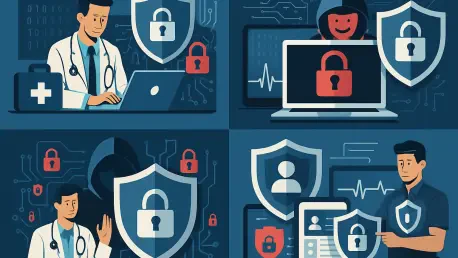The digital transformation of the healthcare sector has undeniably brought significant advancements to patient care, streamlining processes and improving accessibility. However, it has concurrently amplified the risks posed by cyber threats, particularly ransomware attacks. The susceptibility of healthcare organizations to these cyber onslaughts has undeniably increased, placing them in the crosshairs of malicious actors. The industry has witnessed a striking increase in cybersecurity incidents, as highlighted by experts noting over 1,700 incidents in recent years compared to 1,378 the previous year. This surge underscores the sector’s challenges, linked to its vast and interconnected infrastructures, which include critical provider types such as radiology services, pharmacies, and medical transport firms. At the heart of the issue lies the inherently sensitive and valuable information contained within healthcare systems, combined with a heavy reliance on interconnected networks making these systems lucrative targets for ransomware attacks.
Understanding the Ransomware Threat in Healthcare
Healthcare’s allure to cybercriminals stems largely from the immense value and sensitivity of the data it protects. Medical records are a goldmine for cyber adversaries, containing patients’ personal, financial, and health information. Unlike credit card numbers, which can be canceled and changed easily, health records provide immutable specifics. Cybercriminals can exploit these details for identity theft, insurance fraud, and directed scams, knowing that the information cannot be altered easily by affected individuals. This makes healthcare organizations prime targets for ransomware attacks, where sensitive data is held hostage until a ransom is paid. Ransomware incidents not only threaten financial stability but can severely disrupt critical operations, jeopardizing patients’ lives. Data encryption from ransomware can leave hospital systems inoperable, delaying surgeries, mismanaging dosages, and leading to potential loss of life.
The interconnected nature of healthcare infrastructures further exacerbates these risks. Hospitals, clinics, and other healthcare entities often rely on integrated systems to enhance communication and efficiency. While these networks offer operational benefits, they also create vulnerabilities. A breach in one part of the system can cascade, compromising other sections and amplifying the damage. Moreover, the Internet of Medical Things (IoMT), which includes devices connected to patient monitoring systems, widens the attack surface for cybercriminals. Each connected device becomes a potential entry point, creating a web of vulnerabilities that can be exploited through various means such as phishing, malware, and network intrusion. Therefore, the healthcare industry faces a unique set of challenges due to its operational intricacies and data sensitivity, requiring strategic cybersecurity planning.
Mitigation Strategies for Enhanced Security
Mitigating the risks posed by ransomware requires a comprehensive, multifaceted approach to cybersecurity that encompasses technology, policy, and human elements together. One critical measure involves implementing effective cybersecurity education and training programs for all healthcare staff. Employees are often the first line of defense against phishing attacks and malware, making it crucial that they can recognize and respond appropriately to suspicious activities. Regular training sessions and simulated phishing attempts can enhance their preparedness. Additionally, robust incident response plans should be designed, enabling organizations to efficiently manage and contain cyber incidents when they occur.
Network segmentation emerges as another vital strategy for reducing vulnerability. By dividing a network into smaller, isolated segments, healthcare organizations can contain breaches and prevent them from spreading throughout the entire system. This defensive measure involves isolating sensitive data and critical systems from the general network, limiting access strictly to authorized personnel. Advances in technology have made network segmentation more feasible, utilizing automation and AI-driven tools to enforce security policies effectively. Ransomware attacks could be significantly mitigated by creating a well-segmented network environment, ensuring that even if one segment is compromised, others remain unaffected, thus sparing critical operations and sensitive data from being seized.
The Role of Cyber Insurance and Regulations
Cyber insurance policies have become a pivotal mechanism in managing the financial impact of cyber incidents, providing a safety net as organizations navigate the complexities of digital threats. These policies go beyond covering the immediate costs of ransom payments, offering financial support for data recovery, legal fees, and regulatory fines associated with breaches. Furthermore, cyber insurance offers resources for risk management and incident response planning, equipping healthcare organizations with tools and expertise to preemptively address potential threats. Nevertheless, it is crucial to understand that insurance alone cannot fully hedge against risks; it should be part of a broader cybersecurity strategy that includes prevention, detection, and response capabilities.
In response to increasing cyber threat levels, regulatory frameworks are evolving to mandate stronger security measures within the healthcare sector. Recently proposed updates to the HIPAA Security Rule are poised to introduce new technical controls aimed at bolstering cybersecurity defenses. Anticipated measures include requirements for encryption of electronic protected health information (ePHI), implementation of mandatory multi-factor authentication, and maintenance of comprehensive technology asset inventories. By mandating such controls, regulations will urge healthcare organizations to adopt stronger cybersecurity postures. As regulatory landscapes shift, healthcare entities must proactively align their security practices to meet new standards and reduce vulnerabilities that could be exploited by cybercriminals.
Addressing Third-Party Risks and Layered Insurance Strategies
The complexity of healthcare systems is further compounded by their reliance on a myriad of third-party vendors and service providers, each presenting additional cybersecurity risks. Vendor-related breaches have become increasingly prevalent, emphasizing the need for stringent oversight of third-party relationships. It is vital for healthcare organizations to evaluate the cybersecurity posture of their vendors rigorously by implementing contractual requirements for cyber liability policies. Defining the scope of data managed by third parties, including Protected Health Information (PHI) and Personally Identifiable Information (PII), helps assess and mitigate potential risks. A comprehensive strategy involving vendor risk assessments and periodic audits aids in safeguarding sensitive data from vulnerabilities introduced by external parties.
In conjunction with third-party risk management, healthcare organizations should consider a layered insurance strategy to address a wide range of potential exposures. Despite the significance of cyber insurance, additional specialty liability insurance covers, such as Errors & Omissions (E&O) and Directors & Officers (D&O) insurance, are essential to fill coverage gaps. These policies cater to the nuances of different digital risks, from errors in billing systems to litigation stemming from cybersecurity incidents. A layered approach to insurance ensures robust protection against diverse threats and fortifies operational integrity. Strategically integrating insurance into an organization’s overall resilience framework enhances its ability to withstand and recover from cyber incidents, protecting leadership and maintaining continuity.
Strengthening Future Cybersecurity Practices
The digital transformation in healthcare has greatly enhanced patient care by streamlining processes and improving access to services. However, this shift has also increased the sector’s vulnerability to cyber threats, notably ransomware attacks. This rise in susceptibility makes healthcare organizations attractive targets for cybercriminals. Experts have observed a sharp increase in cybersecurity incidents, with over 1,700 cases reported in recent years compared to 1,378 the year before. This trend highlights the challenges faced by the industry, which are tied to its extensive and interconnected infrastructures. These include essential providers such as radiology departments, pharmacies, and medical transportation services. The crux of the issue is the sensitive and valuable data housed within healthcare systems, combined with a dependence on interconnected networks. This combination makes healthcare systems especially appealing to ransomware attacks, as they offer potential financial gain for cybercriminals exploiting these vulnerabilities.









